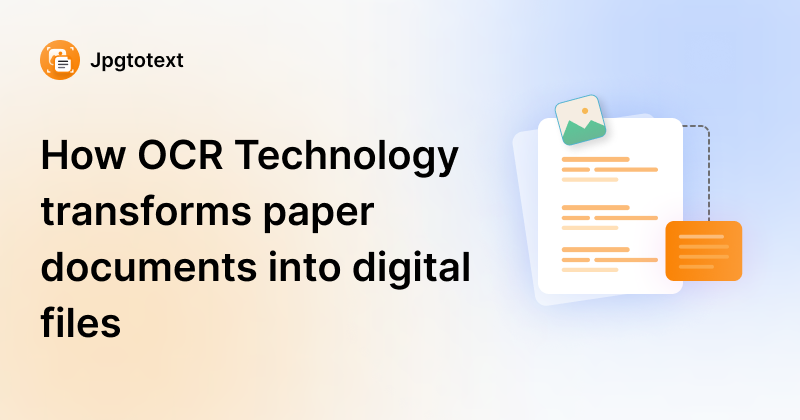
Jan 02, 2025
Converting stocks of paper piles into digital records brings you several benefits such as increased accessibility and searchability, robust data security, easy document management, etc. It’s the need of the hour. Those who haven’t adopted this technology seem to be struggling and missing out on the key benefits of document digitization.
OCR is the only feasible technology that helps you go paperless. There’s no other way. Doing it manually isn’t an option (especially when you have to convert piles of paper documents), because it’s time-consuming and error-prone.
In this blog post, we are going to shed light on what is OCR technology and how it works to turn paper documents into digital, editable text files.
OCR is the abbreviation of ‘’Optical Character Recognition’’ that is used to refer to a technology that converts scanned documents and images containing text into digital text files. This technology works by evaluating the patterns of pixels and spotting characters. Let’s discuss the working mechanism in detail below:
The OCR technology completes the text extraction from scanned documents and photos in a series of steps such as scanning the document, image processing, character/text recognition, and converting the recognized text into editable text.
The first step involves taking a scan or picture of the documents that need to be converted into digital documents. Systems based on OCR technology perform this step autonomously, which are usually employed by businesses that need to perform text extraction on a large scale. However, for personal use, users can easily use their mobile phone camera or a scanner to take a picture of the desired document or handwritten notes and insert it into an OCR-based tool for conversion.
The next step is to process the scanned images to boost the image quality and differentiate text from non-text components such as graphics. This usually involves deskewing, filtering and cropping.
This is when pattern recognition and machine learning algorithms get activated to recognize and compare the segmented characters using the big data sets to identify the right characters forming text with the highest accuracy.
This is the final phase in which the recognized text is converted into a machine-readable document that is editable and can be stored digitally.
These are the steps through which OCR technology performs to extract text from digital scans and images.
A Real Example of an Online Tool that Employs OCR Technology for Image-to-text Conversion
Jpgtotext.info is an online free tool that converts images containing text into editable text using OCR technology. How about testing this tool with an actual text image? It will help you understand the working of OCR in a hands-on manner.
We’ll input any random photo containing text into the tool to see if it can extract text accurately. Here’s the photo that we’ll insert into the tool:

Here’s the tool’s output:

The tool takes only a few seconds to process the image and convert it into machine-readable text, that is easy to edit, search and store online. This is how OCR technology transforms paper documents into digital files.
These OCR converting tools are ideal for users with limited image-to-text conversion needs. Surprisingly, they are free and users can convert as many pictures as they want through the basic free version.
Although OCR technology is evolving at a fast pace, there are still some limitations throwing stones in its way. These include but are not limited to:
It has been observed that OCR technology struggles to extract poorly handwritten text. Converting images containing such text may be challenging for OCR-powered tools at times.
Low resolution and blurry images are another aspect that can give a tough time to OCR-based solutions. Although this issue seems to be fixed by the latest tools like jpgtotext.info, the accuracy may still be compromised for images with poor resolutions or blurriness.
You may see OCR failing to extract the text of less-used languages. This is because it is not trained in all the languages. It works best with widely spoken and understood languages. It won’t perform for ancient Egyptian languages found on the walls of pyramids.
Currently, the OCR technology is incapable of identifying tabular data or text found in complicated forms. This is because it is way more difficult than recognizing simple blocks of text.
Anything interfering with text areas can confuse the OCR technology. It can be watermarks, lines or images that can cause problems.
OCR technology is no less than a god-send gift for those who need to convert paper documents into digital files manually. With this technology, it happens in a matter of a few seconds with the highest level of accuracy. It has become essential for businesses to go paperless, as keeping paper records has lots of drawbacks such as increased labor costs, poor data protection, reduced accessibility, etc.
OCR technology works in different phases: scanning, image processing, character/text recognition and final output generation. Despite real challenges in image quality, handwriting recognition, languages and graphic interference, online OCR converter tools like jptotext.info offer free and effective image-to-text conversions.
It won’t cost you anything to access and employ OCR-based tools like jpgtotext.info. It’s free and doesn’t waste its users’ time through any signup procedure. However, it does come with a premium package that you can unlock by switching to its paid plans. The basic free version is enough for users with limited needs.
Well, it depends on what OCR tool you are using. Some tools like jpgtotext.info use a robust security system to keep their users’ data safe and secure from potential data breaches. It doesn’t use or share user information with any third party.
Yes modern OCR tools are fully equipped to extract text and numbers as well from the images. This is quite useful for students to convert image-based math problems and equations into editable and machine-readable text formats for further use and reference.